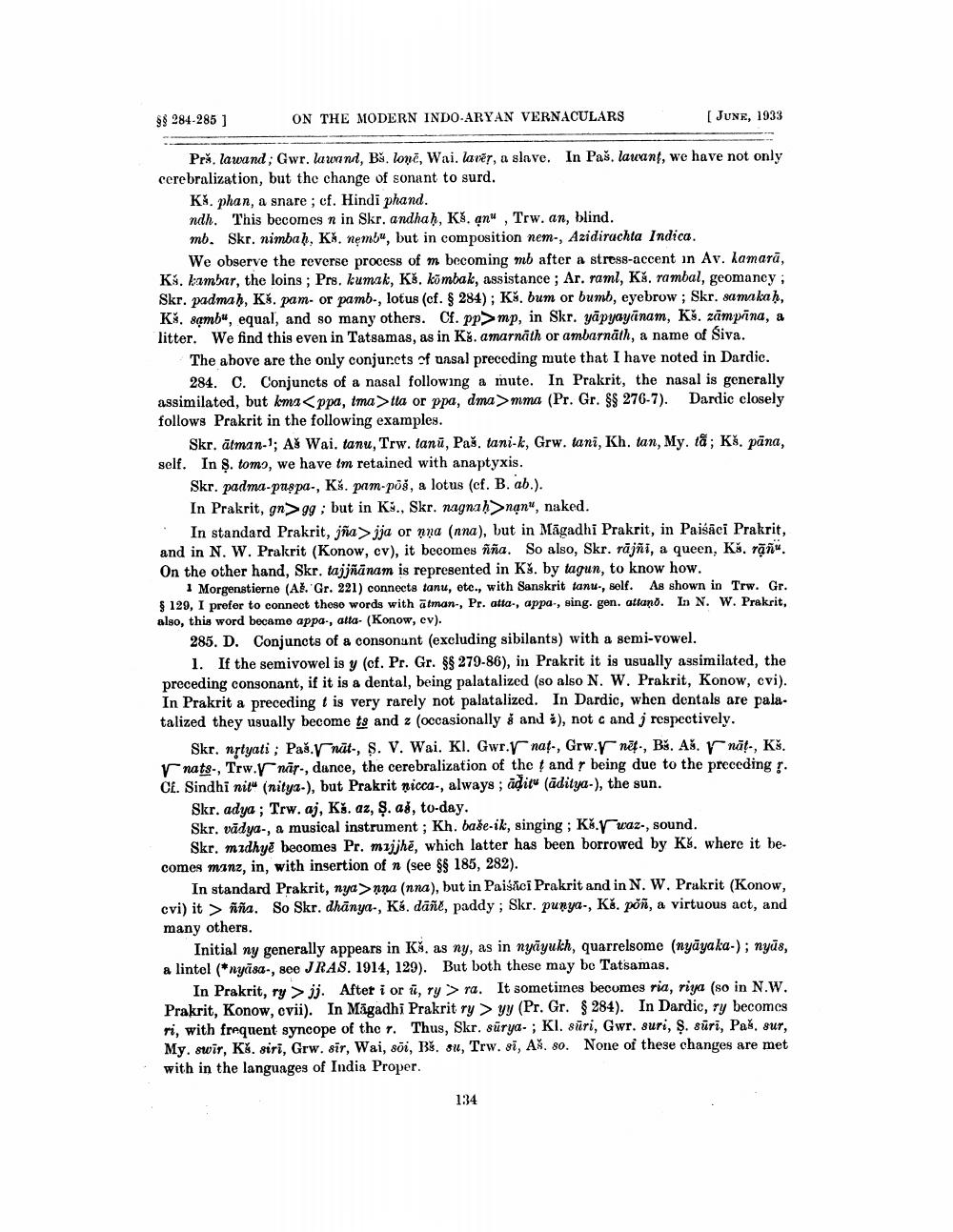________________
ON THE MODERN INDO-ARYAN VERNACULARS
§§ 284-285 ]
[ JUNE, 1933
Prš, lawand; Gwr. lawand, Bs. lone, Wai. laver, a slave. In Paš. lawant, we have not only cerebralization, but the change of sonant to surd.
K. phan, a snare; cf. Hindi phand.
ndh. This becomes n in Skr. andhaḥ, Ks. anu, Trw. an, blind.
mb. Skr. nimbah, K. nemb", but in composition nem-, Azidirachta Indica.
We observe the reverse process of m becoming mb after a stress-accent in Av. kamarā, Ks. kambar, the loins; Prs. kumak, Kš. kombak, assistance; Ar. raml, Kš, rambal, geomancy; Skr. padmaḥ, Kš. pam- or pamb-, lotus (cf. § 284); Ks. bum or bumb, eyebrow; Skr. samakaḥ, Ks. sambu, equal, and so many others. Cf. pp>mp, in Skr. yapyayānam, Kš. zāmpāna, a litter. We find this even in Tatsamas, as in Ks. amarnath or ambarnath, a name of Śiva.
The above are the only conjuncts of uasal preceding mute that I have noted in Dardic. 284. C. Conjuncts of a nasal following a mute. In Prakrit, the nasal is generally assimilated, but kma<ppa, tma>tta or ppa, dma>mma (Pr. Gr. §§ 276-7). Dardic closely follows Prakrit in the following examples.
Skr. atman-1; Aš Wai. tanu, Trw. tanu, Paš, tani-k, Grw. tani, Kh. tan, My. ta; Kš. pāna, self. In S. tomo, we have tm retained with anaptyxis.
Skr. padma-paspa-, Kš. pam-pos, a lotus (cf. B. ab.).
In Prakrit, gngg; but in Ks., Skr. nagnaḥ>nan", naked.
In standard Prakrit, jña>jja or nna (nna), but in Magadhi Prakrit, in Paiśāci Prakrit, and in N. W. Prakrit (Konow, ev), it becomes ñña. So also, Skr. rajni, a queen, Kš. ran". On the other hand, Skr. tajjñānam is represented in Kš. by tagun, to know how.
1 Morgenstierne (Aš. Gr. 221) connects tanu, etc., with Sanskrit tanu-, self. As shown in Trw. Gr. § 129, I prefer to connect these words with atman-, Pr. atta-, appa-, sing. gen. attano. In N. W. Prakrit, also, this word became appa-, atta- (Konow, ev).
285. D. Conjuncts of a consonant (excluding sibilants) with a semi-vowel.
1. If the semivowel is y (cf. Pr. Gr. §§ 279-86), in Prakrit it is usually assimilated, the preceding consonant, if it is a dental, being palatalized (so also N. W. Prakrit, Konow, evi). In Prakrit a preceding t is very rarely not palatalized. In Dardic, when dentals are palatalized they usually become ts and z (occasionally & and %), not c and j respectively.
Skr. nrtyati; Paš.Vnat-, §. V. Wai. Kl. Gwr. nat., Grw.y net., Bs. Aš. Vnāt., Kš. nats-, Trw.nar-, dance, the cerebralization of the t and being due to the preceding r CE. Sindhi nit" (nitya-), but Prakrit nicca-, always; adit" (aditya-), the sun.
Skr. adya; Trw. aj, Ks. az, S. aš, to-day.
Skr. vadya-, a musical instrument; Kh. baše-ik, singing; Kš.y waz-, sound.
Skr. madhye becomes Pr. majjhe, which latter has been borrowed by Ks. where it be comes manz, in, with insertion of n (see §§ 185, 282).
In standard Prakrit, nya>nna (nna), but in Paisñci Prakrit and in N. W. Prakrit (Konow, cvi) it ñña. So Skr. dhanya-, Ks. daně, paddy; Skr. punya-, Kš. poñ, a virtuous act, and many others.
Initial ny generally appears in Kš. as ny, as in nyayukh, quarrelsome (nyāyaka-); nyūs, a lintel (*nyasa, see JRAS. 1914, 129). But both these may be Tatsamas.
In Prakrit, ry>jj. After i or i, ry>ra. It sometimes becomes ria, riya (so in N.W. Prakrit, Konow, evii). In Magadhi Prakrit ry> yy (Pr. Gr. § 284). In Dardic, ry becomes ri, with frequent syncope of the r. Thus, Skr. surya-; Kl. suri, Gwr. suri, S. suri, Paš, sur, My. swir, K. siri, Grw. sir, Wai, soi, B. su, Trw. si, Aš. so. None of these changes are met with in the languages of India Proper.
134




